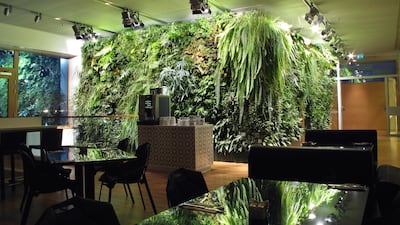In 1982 the German artist Joseph Beuys proposed a work called 7,000 Oaks. This ambitious project involved planting 7,000 oak trees around the German city of Kassel, marked out by 7,000 basalt stones. It was modern art meets green urban renewal, resulting in a work that took five years to complete. The project subsequently spread to other cities around the world, raising awareness about human dependence on the broader ecosystem.
Human existence is inextricably intertwined with plant life in obvious ways – for supplies of oxygen and food, for instance. Similarly, our psychological wellbeing is also greatly enhanced by our proximity to greenery. The late Oliver Sacks, a celebrated neurologist and author, once wrote: "I cannot say exactly how nature exerts its calming and organising effects on our brains but I have seen in my patients the restorative and healing powers of nature and gardens... In many cases, gardens and nature are more powerful than any medication."
There is much research supporting Sacks' clinical observations. The most widely cited study was undertaken by the environmental psychologist Roger Ulrich and published in the journal Science in 1984. This seminal study, titled View Through a Window May Influence Recovery from Surgery, found that patients recovering from gall bladder surgery, whose bedside windows overlooked lush greenery, healed faster, had fewer complications and required less pain medication, than their counterparts whose windows looked out onto brickwork.
This is excellent news for people with gardens or homes looking out onto leafy vistas. However, even urban dwellers without access to a garden or views of wide-open green spaces can still benefit from the psychological balm of nature. Bringing the outside indoors is one way to achieve this. In the UAE, where summer temperatures of up to 50C make it near-impossible to go outside, and many people live in apartments with no access to an outdoor space, the indoor garden might prove to be a vital and therapeutic idea.

The benefits of bringing nature indoors are captured in the international Well building standard, a recognised industry tool to incorporate health and wellbeing into design and infrastructure. Based on decades of scientific research into the health impact of a built environment, the standard has seven critical areas of focus: air, water, nourishment, light, fitness, comfort and mind.
Mind, in this context, is synonymous with psychological wellbeing and to this end, the institute strongly advocates biophilic design, which involves including living and natural elements in the design of buildings. The reason for incorporating nature in our habitats and workplaces is because humans have an innate tendency to connect with the natural world. Plants are the obvious place to start; the Well institute says interiors devoid of nature can seem cold and sterile, with potentially negative impacts on mood, wellbeing and stress levels.
It might be surprising to think that something as simple as a well-placed window box, or some potted shrubbery in our office, might contribute significantly to wellbeing. I am fortunate that my workplace is particularly verdant, with plant life everywhere, inside and out. I also live opposite a house with a magnificent garden. From my window, I can watch the branches of my neighbour's palm trees swaying elegantly on the breeze. Then there are my own house plants, diverse in their shapes and sizes and shades of green.
Some of the world's most forward-thinking companies have embraced the concept of biophilia, which became popular in the 1980s. Last year Amazon opened a new employee lounge and workspace known as the spheres at its headquarters in Seattle. These three, 4,000 square-foot, glass bio-domes are home to more than 40,000 plants, featuring a diverse range of species from more than 30 different countries.
A key argument in favour of biophilic workspaces is that they promote productivity and creativity. A 2014 business report titled The Economics of Biophilia: Why Designing with Nature in Mind Makes Financial Sense presents a compelling case. In one study, a call centre based in California invested $1,000 per employee to ensure everyone had a window looking out onto nature, an investment which resulted in a productivity saving of $ 2,990 per employee.
In terms of nature promoting creativity, perhaps the most famous example is that of Isaac Newton, the apple falling from the tree and his subsequent discovery of the law of gravity. There is a more serious point here, however; if stress reduces our ability to think creatively and being close to nature reduces stress, then indirectly, it promotes creativity too.
Oak trees can live for more than 1,000 years. Beuys' 7,000 oaks are still mere seedlings and will only just have started producing acorns. Who knows how much inspiration and creativity they might sow, for years and generations to come?
Justin Thomas is a professor of psychology at Zayed University




